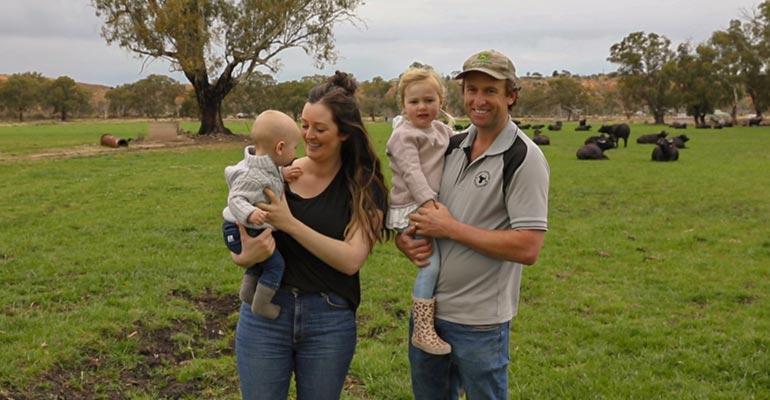When innovative farmer Corey Jones made a bold business decision to take over the family business and start milking buffalo instead of dairy cows, maximising water use efficiency was at the forefront of his thinking and future planning.
Now 31, Corey grew up on his parents' dairy farm in the Murraylands at Mypolonga in South Australia, with a genuine passion for agriculture and farming. His grandfather first bought the farm situated on the banks of the River Murray in the 1960s, and his parents took over management of the property in the 1980s. However, the dairy closed in the 2000s as the Millennium Drought took hold and part of the water licence was sold to pay off debt. At this time, Corey started working off-farm as a builder, learning skills and gaining experience that has proven to be invaluable in reinvigorating the family farm.

In about 2011, he started laying the foundations for his current business enterprise, which he shares with wife Mollie. They sell buffalo milk to a variety of cheesemakers based in Sydney, Melbourne, Adelaide, and the Adelaide Hills. Corey revitalised neglected pastures where dairy cows had once grazed and undertook extensive laser levelling of the irrigated paddocks to boost water use efficiency.
“The biggest challenge in getting the farm up and running again was cleaning up the African boxthorns – it was basically a weed farm for boxthorns. I started that process in about 2011 making improvements for 3 years while working off-farm, when the dairy was sitting idle. Fortunately, dad kept the dairy in good condition mechanically, but milking cows didn't appeal to me.
I spoke to a cheesemaker in the Adelaide Hills about milking goats but instead decided to start milking buffalo. I started in 2014 with 30 buffalo and have expanded to about 260 head and we milk anywhere from 50 to 100 all-year-round. Milking is the main thing we do but we also have a good beef trade which provides another solid income stream. As well as leasing his parents' original farm, Corey is leasing land from his neighbours, taking the total area to about 100 hectares of river flats.
I'm lucky because mum and dad didn't sell off the full water licence. They sold off part of the licence to get out of debt, but dad was adamant he'd never sell his water licence so that makes life a lot easier now. Irrigation is vital for the farm in terms of growing the grasses and there's a much better profit margin in growing my own feed rather than buying hay and bringing feed in. All of the buffalo are fed on a combination of grass and hay and, at times, I grow my own hay when there's excess feed. If I was trying to irrigate paddocks to grow pastures, in the condition they used to be in about 8 years ago, it would make life so much harder because the water wouldn't run efficiently and go as far. But I'm grateful to have access to water which is vital for bringing life to the farm and I watch my water meter extremely closely so that I know exactly how much I'm using."
Corey said efficient use of irrigation water was intrinsically linked to the farm's profitability.
"I don't want to waste any water because it's so valuable and the laser levelling makes the farm way more efficient. Now that the farm is laser levelled, it's an ongoing thing for me to continually improve paddocks and our water use.
I'm in it for the long haul. I've taken on debt to build up the farm and have a young family now which motivates me to keep going and making positive changes to keep the business going."

Corey said he built his herd starting with buffalo sourced from a government-run farm in Darwin which had been breeding them for 10–15 years; starting with older swamp buffalo before moving into Italian Riverine buffalo which are a better milking breed. He said developing the buffalo milk market was also key to his future plans.
“I've got cheese makers in Melbourne, Sydney, Adelaide, and Adelaide Hills that I shuffle the milk around to. Melbourne and Sydney have strong markets for buffalo mozzarella and Adelaide has a growing market for that product too. In the Adelaide Hills at Woodside Cheese they do a buffalo fetta and other speciality cheeses which I've tried, and they taste really good, but of course I'm a bit biased. A lot of the buffalo mozzarella is sold in restaurants or in the Adelaide Hills speciality supermarkets to people who want to make a good pizza at home. It's taken a long time to build the buffalo milk market up, but we've got here now and we're going to keep growing it.
I was devastated when my parents shut the dairy down because farming was all I ever wanted to do, but in the long run it was better because I went off and got a trade and now I'm using those skills on the farm, to make improvements, such as laser levelling the paddocks to improve water use. I've grown up with the River Murray all of my life swimming or water skiing and fishing for yabbies and now I'm able to make a living from it which is a great lifestyle and I hope to continue for as long as possible. I'm still young and want to do the best I can to have the best and healthiest farm possible."